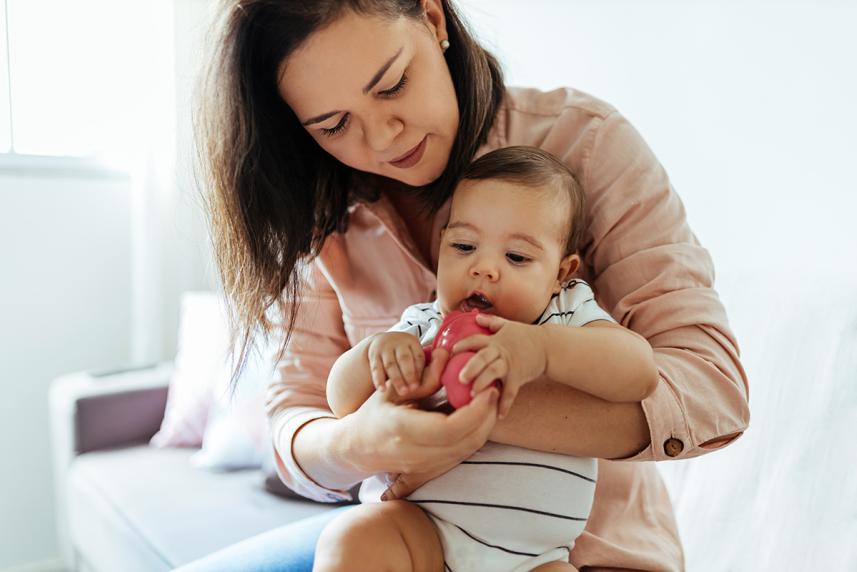
Dos and don’ts of teething

Incoming baby teeth can cause tender, sore gums. Here’s advice from pediatricians on which remedies to try and which to skip.
Red gums. Drooling. Trouble sleeping. These are all common signs that your baby is teething. Your infant’s teeth start coming in around 4 to 7 months, according to the American Academy of Pediatrics (AAP).
This is an exciting milestone for parents. “Many infants are ‘happy teethers.’ That means they smile, coo or babble, along with lots of gnawing and drooling,” says Leah Alexander, MD. She’s a pediatrician with Pediatric Care Associates in Fair Lawn, New Jersey.
But sometimes, teething can cause gum swelling and pain. Here are pediatrician-approved tips about what to do — and what not to do — to make your baby feel better.
Do massage their gums
Use your finger to gently massage your little one’s gums. Just make sure your hands are clean. You can even dip your finger in cool water first for added pain relief. This may be especially helpful if your baby likes to chew on your nipples while breastfeeding. Quick gum massages before nursing may help stop painful chewing.
Be sure to use your pinkie finger to prevent your infant from gagging, says Dr. Alexander. Also, keep your fingernails short to avoid scratching their gums.
Shop for all your baby and new-mom needs at the Optum Store and have products shipped directly to your front door.
Don’t let them chew on anything sharp
“I often hear of families giving their babies chicken bones or corn on the cob,” says Emily Wisniewski, MD. She’s a pediatrician with Mercy Family Care in Baltimore, Maryland. But those kinds of items have sharp edges that can cut your baby’s gums. They’re also potential choking hazards.
Do try chilled teething toys
Teething toys made of BPA-free plastic or silicone are great for soothing achy gums. Chill them in the refrigerator ahead of time. The cold can feel good on your baby’s gums.
You can also use a damp washcloth that has been twisted and chilled in the freezer for 15 to 30 minutes, according to the AAP. Simply tie one end in a knot for your baby to gnaw on.
“I like using a mesh feeder and putting in some frozen fruit so they can chew on it,” says Gina Posner, MD. She’s a pediatrician at MemorialCare Orange Coast Medical Center in Fountain Valley, California. Be sure to avoid any fruit with seeds.
Don’t give your baby a frozen teething ring, though. “The rubber may crack and cause the liquid to leak,” says Dr. Alexander. They’re also too hard for babies to chew on.
Don’t use teething jewelry
Never use teething necklaces or bracelets. These products are made from materials such as amber, wood, marble or silicone. And they are not safe, according to the U.S. Food and Drug Administration (FDA).
“They can easily break, causing an infant to choke on the beads,” says Dr. Alexander. The necklace can also be a strangulation risk if the baby wears it around their neck.
Some retailers claim that amber beads can release pain-relieving substances or boost a baby’s immune system. But there is no evidence to support those claims, says the AAP.
Do try a safe over-the-counter remedy
Is your baby’s teething so painful that it’s interrupting his or her sleep and daily activities? Talk to your pediatrician about giving them infant's acetaminophen. Give your baby only the dose recommended by your doctor.
You can also try a nonmedicated cooling gel or cream that you rub on your baby’s gums. Just make sure it’s a formula made for babies. Caution: It should say “benzocaine free” on the label. A topical gel that contains benzocaine is not safe for babies.“Benzocaine is a topical anesthetic that can numb the gums and also the throat, which can make it hard for your baby to swallow,” Dr. Alexander says.
Another thing to avoid? Homeopathic teething tablets that contain belladonna or caffeine (coffea cruda). These are not FDA-approved and pose a risk to babies.
When in doubt, talk with your pediatrician about the best teething remedies for your little one.

Additional sources
Teething timing: American Academy of Pediatrics (2016). “Teething: 4 to 7 months”
Teething toys: American Academy of Pediatrics (2014). “How to Help Teething Symptoms Without Medications”
Safety risks: U.S. Food and Drug Administration (2018). “FDA warns about safety risks of teething necklaces, bracelets to relieve teething pain or to provide sensory stimulation”
Homeopathic remedies: U.S. Food and Drug Administration (2019). “FDA warns consumers about homeopathic teething products”
